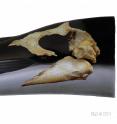Ancient New Zealand 'Dawn Whale' identified by Otago researchers
University of Otago palaeontologists are rewriting the history of New Zealand's ancient whales by describing a previously unknown genus of fossil baleen whales and two species within it. Otago Department of Geology PhD student Robert Boessenecker and his supervisor Professor Ewan Fordyce have named the new genus Tohoraata, which translates as 'Dawn Whale' in Māori.
The two whales, which lived between 27-25 million years ago, were preserved in a rock formation near Duntroon in North Otago. At that time the continent of Zealandia was largely or completely under water and the whales were deposited on a continental shelf that was perhaps between 50 to 100 metres deep.
The new genus that the fossils represent belongs to the toothless filter-feeding family Eomysticetidae, and it is the first time members of this family have been identified in the Southern Hemisphere.
They named the younger of the two fossil whales, which may be a descendent of the elder, as Tohoraata raekohao. Raekohao means 'holes in the forehead'.
Mr Boessenecker says this whale lived between 26-25 million years ago and vaguely resembles a minke whale but was more slender and serpent-like. Its skull, which contains a number of holes near its eye sockets for arteries, was probably about two metres in length and the whole animal would have been eight metres long.
"This new species differs from modern baleen whales in having a smaller braincase and a skull that is generally much more primitive, with substantially larger attachments for jaw muscles. The lower jaw retains a very large cavity indicating that its hearing capabilities were similar to archaic whales."
The researchers also determined that the older fossil whale from the site, which was collected in 1949 and named in 1956, had been misidentified as belonging to the genus Mauicetus, a more advanced type of whale called a "cetothere." They have now changed its name from Mauicetus waitakiensis to Tohoraata waitakiensis.
Mr Boessenecker says this particular fossil had been poorly understood for more than 50 years and only with this study was it proven not to be from its originally attributed genus. The two whales have now become the first eomysticetids to be reported outside of South Carolina, USA, and Japan.
"Researchers contend with confusing or surprising fossils in museum collections all the time. Often, the best way to solve these mysteries is to go out and dig up another one, which is what Professor Fordyce and his colleagues did in 1993 when they collected the partial skull of Tohoraata raekohao."
Eomysticetids occupy an important position in the evolutionary tree of cetaceans: they are the earliest toothless baleen-bearing cetaceans, and in many characteristics are intermediate between toothed baleen whales and modern baleen whales, he says.
"They are the first baleen whales to have been completely toothless, and are therefore the earliest known cetaceans to have wholly relied upon filter feeding."
Source: University of Otago
Other sources
- Ancient New Zealand 'dawn whale' identifiedfrom Science DailyWed, 19 Nov 2014, 19:31:14 UTC
- Ancient New Zealand 'Dawn Whale' identifiedfrom PhysorgTue, 18 Nov 2014, 22:30:45 UTC
